April 3, 2024
More With Less: Working With the Washington Naval Treaty
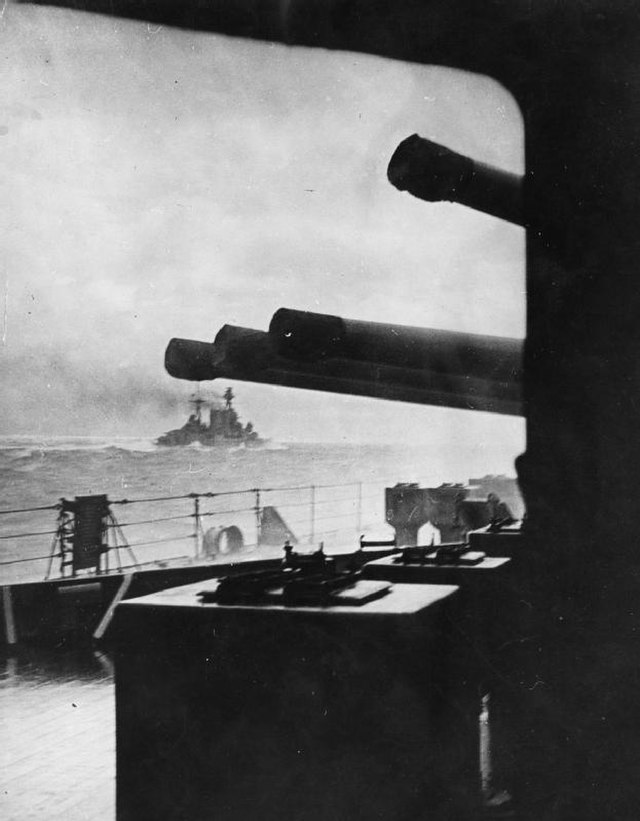
On May 15th, 1920, the British Royal Navy commissioned the battlecruiser HMS Hood. At 860 feet long, 104 feet wide, and displacing over 41,000 tons of water, she became the largest warship on the seas for two decades.
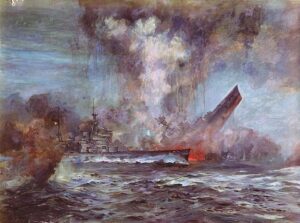
With over 1,400 crew on board, 21 years and 4 days later, a 15-inch diameter shell struck HMS Hood amidships, cutting her in half in a titanic detonation of molten steel and fire. Less than five minutes later, the ship and her crew slipped beneath the icy waters in the Denmark Strait. Only three men survived. Such catastrophes provide a chilling and stark reminder that the way a warship is designed is the the razor-thin line on which over a thousand lives teeter. Up until 1922, these designs were primarily dictated by physics, engineering capability, and most importantly, by how much money a country was willing to shovel into the mouths of its admirals and shipyards. However, the Washington Naval Treaty changed everything.
On the eve of the First World War, the German Empire and the United Kingdom were in the midst of a naval arms race, each rushing to build more dreadnought battleships than the other. By the end of the war, the German High Seas Fleet lay at rest on the bottom of Scapa Flow, and the Royal Navy reigned supreme on the world’s waters. However, this supremacy was not set in stone; the Japanese and United States would, in time, each vie for the coveted position of apex predator of the world’s navies. By 1921, another naval arms race loomed large on the horizon. But, the world of 1921 was not the one of 1914, as public and national interests had shifted away from the desire for yet another arms race, and in November of 1921, a conference on the topic of naval disarmament was called, in Washington D.C.1
______________________________________
The beginning of the Washington Naval Treaty reads:
THE United States of America, the British Empire, France, Italy and Japan;
Desiring to contribute to the maintenance of the general peace, and to reduce the burdens of competition in armament; Have resolved, with a view to accomplishing these purposes, to conclude a treaty to limit their respective naval armament, and to
that end have appointed as their Plenipotentiaries…
It took around 4 months of debate before the Washington Naval Treaty was signed on February 6th, 1922, its terms being wide ranging and restrictive. Many of the capital ships (by this point, battleships and battlecruisers) constructed before the Battle of Jutland in 1916, were required to be scrapped (or in some cases, disemboweled and unable to be returned to service), as were most new battleships under construction when the treaty was signed, with a few exceptions to this rule.
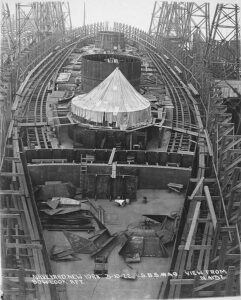
The United Kingdom was forced to destroy 23 of their capital ships; the United States 30; and Japan was forced to destroy 17. This left these three naval powers with differing amounts of tonnage (weight) worth of capital ships: the United States and United Kingdom were each allowed 525,000 tons worth of capital ships, while the Japanese were left with 315,000 tons worth of capital ships. This amounted to a fleet strength ratio of 5:5:3 among the great naval powers. In addition to placing overall limits on the tonnage worth of capital ships the powers were allowed to have, the Washington Naval Treaty also put in place a total ban on the construction of new capital ships for 10 years, and after this “battleship holiday” was over, the signing powers could not construct any new battleships displacing over 35,000 tons, nor could said ships have main guns with a caliber larger than 16 inches.234
______________________________________
While these restrictions on capital ships provided a limited set of possibilities for their design and construction, other terms, or rather, lack of terms, regarding some other types of ships would create new opportunities, and the great navies were now keen to do more with less, and the primary way this was done in the 1920s and 1930s was through two “C’s”: carriers and cruisers. In the treaty, it was stated that ships displacing under 10,000 tons could not carry guns with a larger caliber than 8 inches; however, these ships would not be limited in their numbers by the treaty, and the lack of any restrictions on these smaller ships resulted in a new arms race taking place; this time among cruisers, destroyers, and submarines. 5 The three major navies had differing aims and ideas on how and why they needed cruisers in their naval registers: The Imperial Japanese Navy needed to defend their own territory, which was the most compacted of the three, and as a result, their strategy revolved around constructing very powerful cruisers, capable of fighting other cruisers in the battleline, and as a result, the I.J.N. did not need as many as the other two powers. Similar to Japan, the U.S. Navy wished to produce well-armed, powerful cruisers to work within the battlefleet and secure communication links with territories far flung from the continental United States. The British Royal Navy differed in their ideal strategy, preferring a large amount of cruisers in order to secure their colonial links and shipping. This conflict would eventually come to a head in a later naval conference, but this was several years coming when the first “treaty cruisers” began to leave the slipways. 6
Some classes of these “treaty cruisers” were the Pensacola class, and its better engineered sibling, the Northampton Class, the first two classes of treaty cruisers built for the U.S. Navy. Rather than functioning as an upper limit for the design and construction of cruisers, the terms of the Washington Naval Treaty acted as a baseline for all cruisers. The ceiling had become the floor. As a result, both of these classes displaced just under 10,000 tons, and were armed with a large number of 8-inch guns serving as their main battery. The Pensacola class carried ten 8-inch guns and could also make a speed of 32 knots, a rather fast speed considering their size and armament, and especially when compared to the U.S. Navy’s battleships at the time, none of which could make faster than 21 knots.
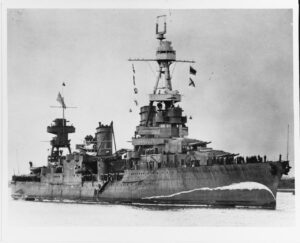
Unfortunately, to achieve this massive main battery at a decent speed, something had to be sacrificed, and in the case of the majority of the “treaty cruisers”, this was armor protection. At its thickest, the Pensacola class’s armor belt was 4 inches. With such a light amount of armor protection, it was effectively a hopeless effort to attempt to guard against the 8-inch guns being carried by every cruiser since the treaty’s enaction. 7 Rear Admiral Claude Bloch, then Chief of the Bureau of Ordinance, remarked:
The side armor that you add, the additional weight you add over former side armor and magazines, doesn’t purchase you very much in protection against an 8 in. gun. For instance, you increase an inch of armor on the side and I think it gives you only a protection of about 1500 or 2000 yards at normal [90 degrees target angle] impact, and the 8 in. gun is so effective at those ranges that I don’t see that your side armor is any great assistance to you provided you have enough over these magazines to protect against 5 in. or 6 in. guns on destroyers close in. For that reason I favor taking as much as can be spared from the side rather than the deck. I think the 1 and 3/4 in. deck is very good and, while three inches would be better, I think the additional protection you gain by keeping the additional protection on the side is better for the reason that it gives you efficient protection against 6 in. guns, and some foreign destroyers carry 6 in. guns. So, my recommendation would be to subtract what you have on the vertical line and leave the horizontal as you have it as reasonably adequate . . . 8
And Admiral Bloch was right; it would be impossible for a 4-inch armor belt to stop a shell fired from a gun twice the caliber of the armor belt, so it would be preferable to armor the ship to be able to withstand impacts against more, smaller guns over more of its vital core. Due to the limitations of the Washington Naval Treaty, most of the cruisers constructed under its terms needed to sacrifice their armor should they have been constructed in compliance with the treaty (the importance of which cannot be understated due to the need to maintain the legitimacy of the treaty system, or at least forestall its collapse), with an adequate gun battery to be able to combat other, similar cruisers of opposing navies, decent seakeeping abilities and machinery spaces, something that the Northampton class improved upon compared to the Pensacola class, and a fast enough top speed to be able to strike opposing shipping and also provide a screen for, what was at the time of the Washington Treaty, an up-and-coming player in the grand naval chessboard; the aircraft carrier.910
______________________________________
Without taking the analogy too literally, when thinking of surface warfare as a chessboard, the aircraft carrier is the king; it has hardly any striking power on its own against other surface ships, and it relies on other, more capable ships to defend it from the opposition. However, unlike chess, this king would eventually be able to launch swarms of aircraft capable of destroying assets from beyond the the board. And yet, it would take decades for the aircraft carrier to become the effective asset that it was during the Second World War, and the Washington Naval Treaty shaped this development.
The treaty allocated 135,000 tons of weight’s worth of aircraft carriers to the U.K. and U.S. The Japanese were allowed to build 81,000 tons worth of aircraft carriers, and the French and Italians were each allowed 60,000 tons for carriers. In addition, there was a cap placed on the size of each individual carrier; an aircraft carrier could not be built over a weight of 27,000 tons. 11
There were some exceptions to the 27,000 ton rule; the U.S. Navy wished to convert two under-construction battlecruisers into aircraft carriers; these two ships were the Lexington (CV-2, not to be confused with its successor, CV-16) and Saratoga, and they weighed in at 33,000 tons each. In return for being allowed to convert these two aircraft carriers, the Japanese were allowed to convert two large battlecruiser hulls that were supposed to be scrapped as well; these two were Akagi and Amagi. Amagi unfortunately never made it to service as an aircraft carrier, as she was totaled by the 1923 Great Kanto Earthquake that leveled Tokyo, and so the battleship Kaga was selected for conversion instead. 12
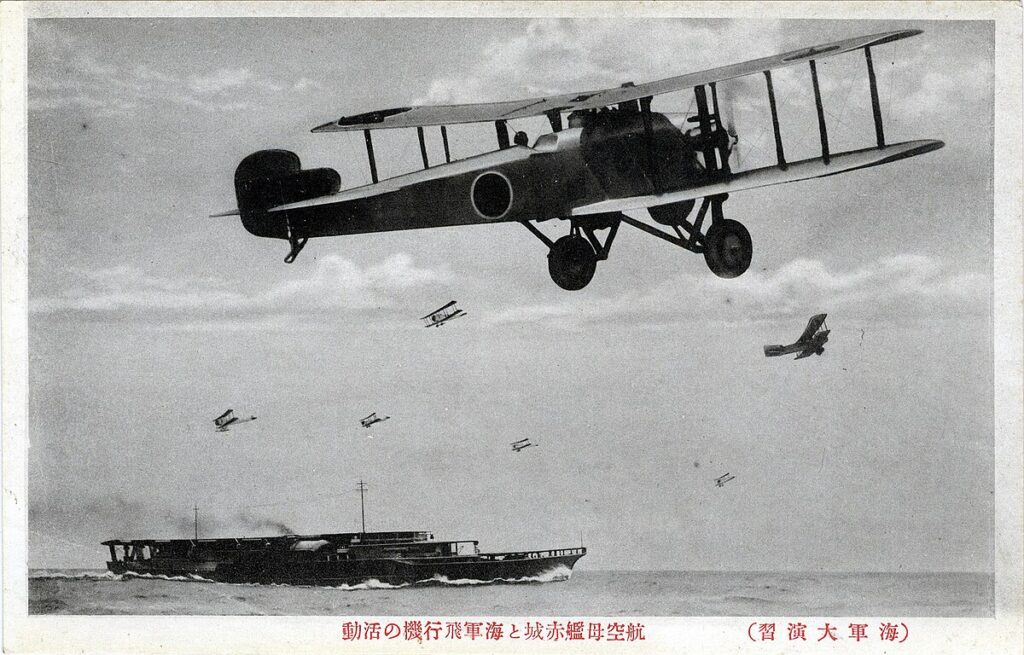
With battleship construction halted, the technologies that drove the development of these magnificent vessels stagnated, as development shifted over to cruisers and carriers.13 In 1919, the British Royal Navy spearheaded the development of aircraft carriers, with Japan and the U.S. seemingly lagging behind. However, within a few short years, this state of affairs would be turned on its head; by 1927, the Imperial Japanese Navy had conducted a large fleet exercise with Akagi that had contributed to a reorganization and expansion of their naval air forces, where as by 1927 the Royal Navy had only just managed to get one of its officers commanding a flight of naval aircraft, its officers lagging behind the Japanese in experience and expertise commanding naval air units. In comparison to the U.S. Navy, the situation was just as abysmal; in 1929, Royal Navy observers were present that year for a fleet exercise that included the Lexington and Saratoga, the first time the carriers had played a striking role in the exercises. The Saratoga’s mock attack on the Panama Canal during this exercise was a resounding success, and demonstrated to the U.S. Navy that a carrier could be utilized as an effective striking force within the fleet. The Royal Navy’s lack of priority on developing their naval aviation and carrier tactics led to dire consequences that were not fully realized until the Second World War had begun, and for this, the implement through which Britannia ruled the waves paid a high price. 14
______________________________________
While the Washington Naval Treaty did make a valiant effort towards limiting naval rearmament and compromise, there were still conflicts and resentment brewed as a result of the treaty; particularly in Japan.
Even before the First World War, the Imperial Japanese Navy had come to realize two related things: the United States would be the most likely opponent of the Japanese, and thus, to defeat the U.S. Navy, the I.J.N. calculated that would they need to have a force that was at least 70% the size of the U.S. fleet operating in the Pacific in order to reliably achieve victory in a pitched decisive battle. The U.S. Navy had also come to this conclusion independently, and thus realized that they would have to prevent the Japanese from attaining a 70% strength ratio in order to attain victory according to their own war plan; War Plan “Orange”. 15
Unfortunately for the I.J.N., they were never going to be able to shovel as much money into the mouths of their shipyards as compared to the United States, due to a postwar recession which led to budgetary constraints, and the fact that the United States’ industrial capacity was several magnitudes larger than that of Japan. Japanese diplomats in Washington, conscious of this fact, and also wishing to maintain some semblance of decent relations with the United States, accepted the 60% (or 5:3, as mentioned earlier) strength ratio, but with a caveat that was offered by the United States. With the Washington Naval Treaty, the Japanese had lost out on the almighty 70% strength ratio, a massive downside; but, they had gained something else: Article XIX of the treaty prevented the U.S. and U.K. from constructing further naval facilities or fortifications in most of their Pacific holdings, a fact that would allow the Japanese to seize these islands far easier in the case of a war, and also limited the strategic and deployment abilities of the U.S. Navy and Royal Navy. 16 17
Back in Tokyo, much of the I.J.N.’s upper echelons were livid, with the dreaded 60% strength ratio haunting their nightmares and the 70% ratio they longed for effectively executed by firing squad. However, the conflict between the officers in favor of the treaty and officers opposed to the treaty continued into the 1920s and 1930s. And as time wore on, and political machinations turned and ground, the faction opposed to the Washington Treaty ultimately won out; this faction attaining power within the I.J.N. would eventually spell the end for the Japanese adherence to the treaty system of naval arms limitations; and in 1936, the Japanese withdrew from the Second London Naval Conference, years of resentment over the treaty finally coming to a conclusion: the Japanese would no longer be slighted and limited in their naval ambitions by a mere piece of paper. 18
______________________________________
By the time the treaties collapsed in the mid-late 1930s, a question would loom large in the years that followed: “Did the Washington Naval Treaty and its successors successfully limit naval armament?” The answer to this broad question invokes a broad answer: Yes, and no. The treaty successfully managed to halt the construction of new battleships, thus preventing another dreadnought race and the massive costs associated with it, saving national economies; but during the 1920s, when cruisers, destroyers, and submarines were not limited in their number, the navies of the world simply switched their construction focuses onto these combatants instead, shifting the naval arms race down from battleships being the primary subject of the building frenzy to cruisers, and by the time another treaty attempted to restrict the number of cruisers 10 years after Washington, the damage had already been done; the great navies had already built dozens of well armed, fast cruisers that had not existed in such numbers or as well armed previously. The Washington Naval Treaty, even though it didn’t intend to, effectively birthed a new category of cruiser: the heavy cruiser. Armed with 8-inch guns and speeds in excess of 30 knots, what these ships lacked in armor under the terms of Washington they made up for in armament, speed, and numbers. This shift away from the battleship also helped to spur the development of the aircraft carriers (the doctrines and usage of which were done more effectively in some forces than in others) that may have not come as quickly if the treaties had not been enacted and battleships had continued to be built.
The Washington Naval Treaty forced the navies bound by it to do more with less. As time wore on, the warships bound by the terms of the treaty became increasingly vulnerable; and by the time that ships not bound by the terms of the treaty left slipways around the world, the ships that were restricted found themselves hard pressed to compete. The treaty cruisers ended up fighting battles during the early years of Second World War, and while they did hold the line for this time, these ships did so at a massive cost. One only needs to look at the map where the ships sank to the floor of Ironbottom Sound off Guadalcanal, the site of some of the most brutish naval warfare during WWII, to see that there is always a price to doing more with less.
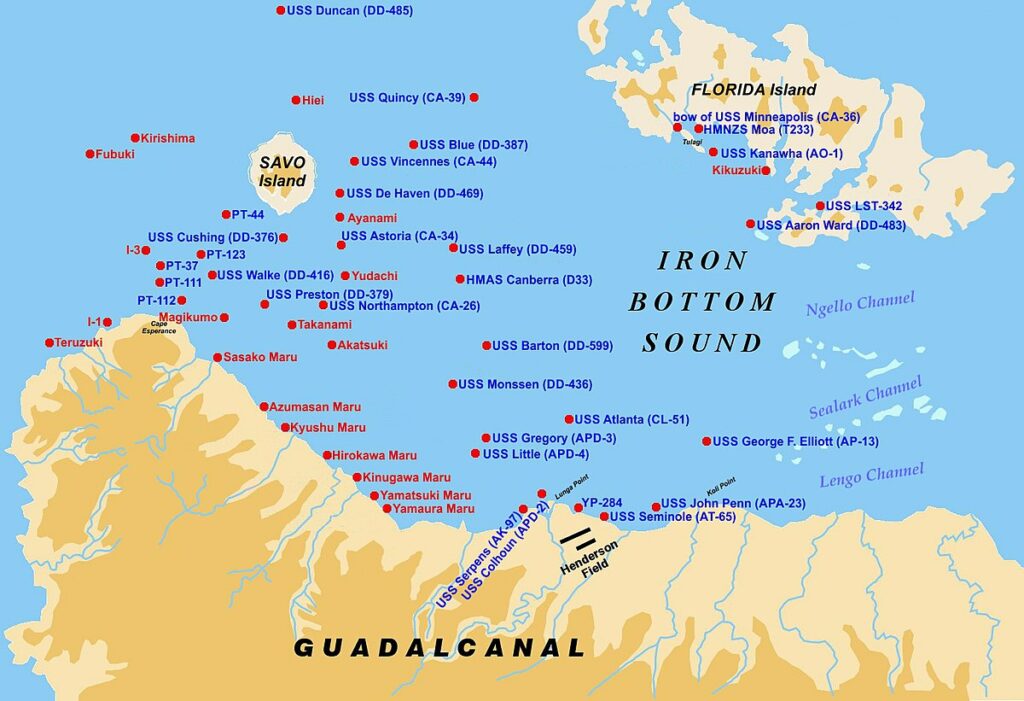
- A. D. Baker, “Battlefleets and Diplomacy: Naval Disarmament Between the Two World Wars,” Warship International 26, #3, (1989) 217–55, 223. ↵
- A. D. Baker, “Battlefleets and Diplomacy: Naval Disarmament Between the Two World Wars,” Warship International 26, no. 3 (1989): 217–55; P. 223-224. ↵
- Strafford Morss, “The Washington Naval Treaty and the Armor and Protective Plating of USS ‘Massachusetts’: Part I,” Warship International 43, no. 3 (2006): 273–309; P. 274-275 ↵
- “TREATY BETWEEN THE BRITISH EMPIRE, FRANCE, ITALY, JAPAN AND THE UNITED STATES OF AMERICA FOR THE LIMITATION OF NAVAL ARMAMENT.” H.M. STATIONERY OFFICE, 1924. ↵
- A. D. Baker, “Battlefleets and Diplomacy: Naval Disarmament Between the Two World Wars,” Warship International 26, no. 3 (1989): 217–55; P. 226. ↵
- Ernest Andrade, “The Cruiser Controversy in Naval Limitations Negotiations, 1922-1936,” Military Affairs 48, no. 3 (1984): 113–20; P.113-114 https://doi.org/10.2307/1987484. ↵
- Christopher C. Wright, “Comparative Notes on U.S. Treaty Cruiser Design,” Warship International 17, no. 4 (1980): 311–32; P. 312-314. ↵
- Christopher C. Wright, “Comparative Notes on U.S. Treaty Cruiser Design,” Warship International 17, no. 4 (1980): 311–32; P. 313. ↵
- Christopher C. Wright, “Comparative Notes on U.S. Treaty Cruiser Design,” Warship International 17, no. 4 (1980): 311–32; P. 312-314. ↵
- Thomas C. Hone, “The Effectiveness of the ‘Washington Treaty’ Navy,” Naval War College Review 32, no. 6 (1979): 35–59; P. 55-57. ↵
- “TREATY BETWEEN THE BRITISH EMPIRE, FRANCE, ITALY, JAPAN AND THE UNITED STATES OF AMERICA FOR THE LIMITATION OF NAVAL ARMAMENT.” H.M. STATIONERY OFFICE, 1924. ↵
- A. D. Baker, “Battlefleets and Diplomacy: Naval Disarmament Between the Two World Wars,” Warship International 26, no. 3 (1989): 217–55; P. 226. ↵
- A. D. Baker, “Battlefleets and Diplomacy: Naval Disarmament Between the Two World Wars,” Warship International 26, no. 3 (1989): 217–55; P. 247. ↵
- Thomas C. Hone and Mark D. Mandeles, “Interwar Innovation in Three Navies: U.S. Navy, Royal Navy, Imperial Japanese Navy,” Naval War College Review 40, no. 2 (1987): 63–83; P. 63-79. ↵
- Sadao Asada, “The Revolt against the Washington Treaty: The Imperial Japanese Navy and Naval Limitation, 1921-1927,” Naval War College Review 46, no. 3 (1993): 82–97; P. 82-84. ↵
- Sadao Asada, “The Revolt against the Washington Treaty: The Imperial Japanese Navy and Naval Limitation, 1921-1927,” Naval War College Review 46, no. 3 (1993): 82–97; P. 84-87. ↵
- “TREATY BETWEEN THE BRITISH EMPIRE, FRANCE, ITALY, JAPAN AND THE UNITED STATES OF AMERICA FOR THE LIMITATION OF NAVAL ARMAMENT.” H.M. STATIONERY OFFICE, 1924. ↵
- Sadao Asada, “The Revolt against the Washington Treaty: The Imperial Japanese Navy and Naval Limitation, 1921-1927,” Naval War College Review 46, no. 3 (1993): 82–97; P. 91-95. ↵
Tags from the story
Japanese navy
London Naval Treaty
Naval Disarmament
Naval Treaties
Nomination-Social-Sciences
Royal Navy
U.S. Navy

Joseph Reed
Joseph is an undergraduate History and Political Science student of the St. Mary’s Class of 2026. He enjoys reading, studying history, and writing stories.
Author Portfolio Page
Quinten Mero
Great work Joseph! Until now I was completely unaware that there was such a treaty that limited naval production standards in such a way during the inter-war period. I find it ironic that the Washington Treaty’s attempt to prevent an arms race developed into not only a new arms race but into the birth of a completely new class of warships.
25/04/2024
11:13 pm